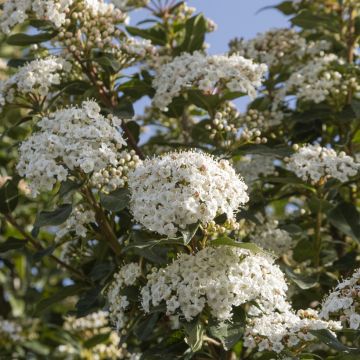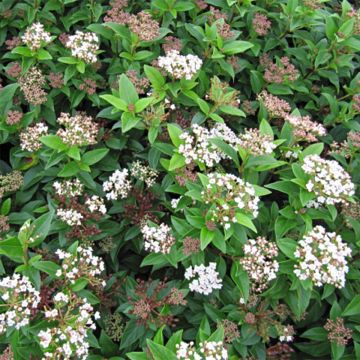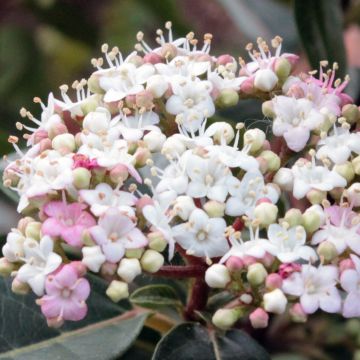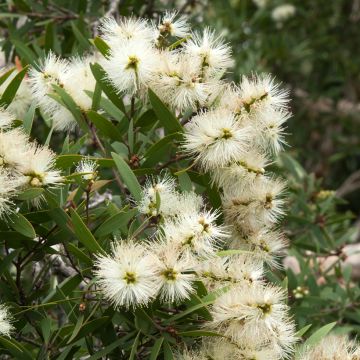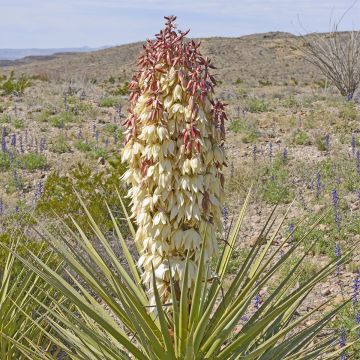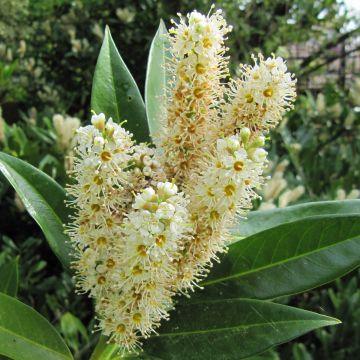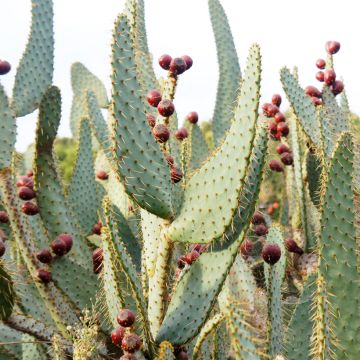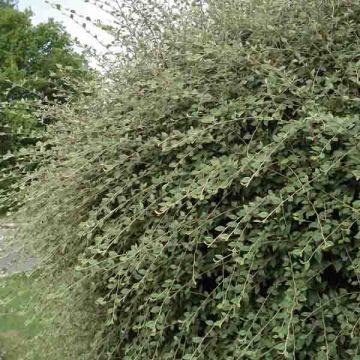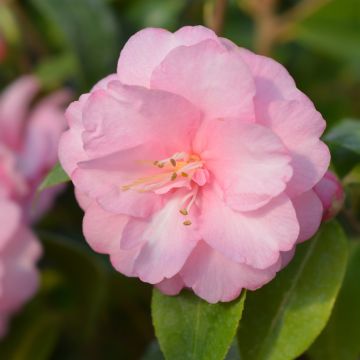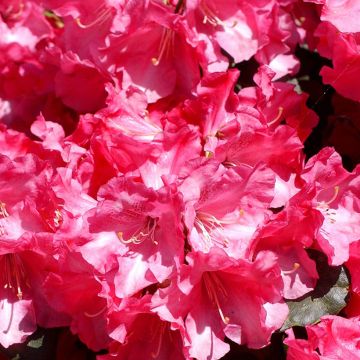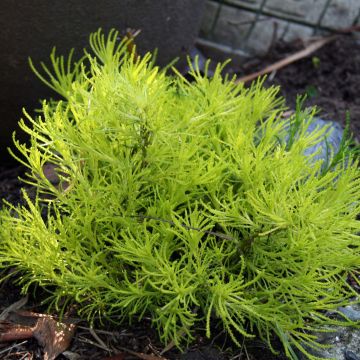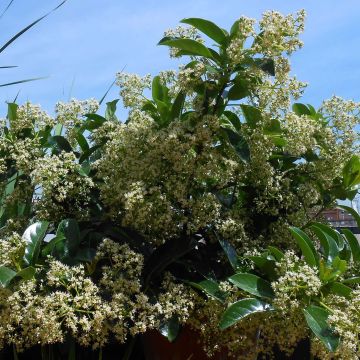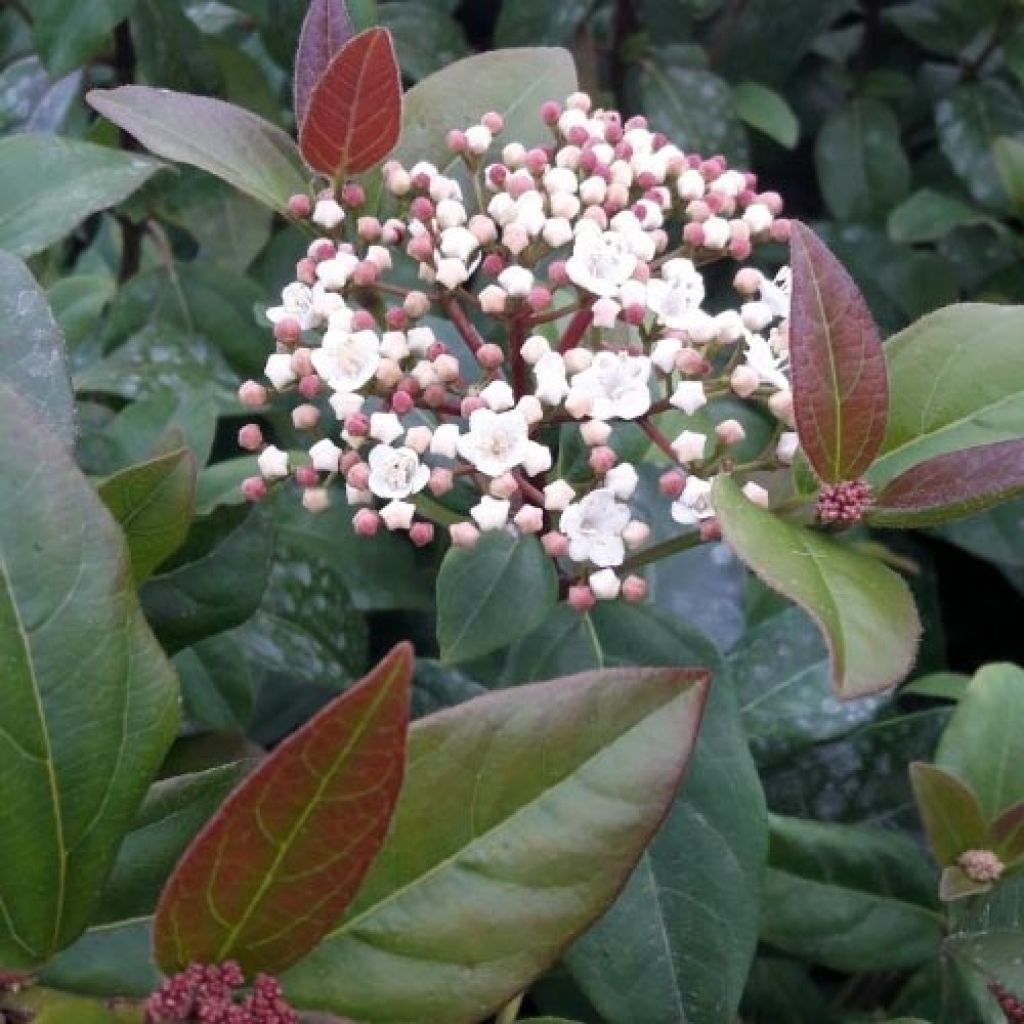

Viburnum tinus Purpureum
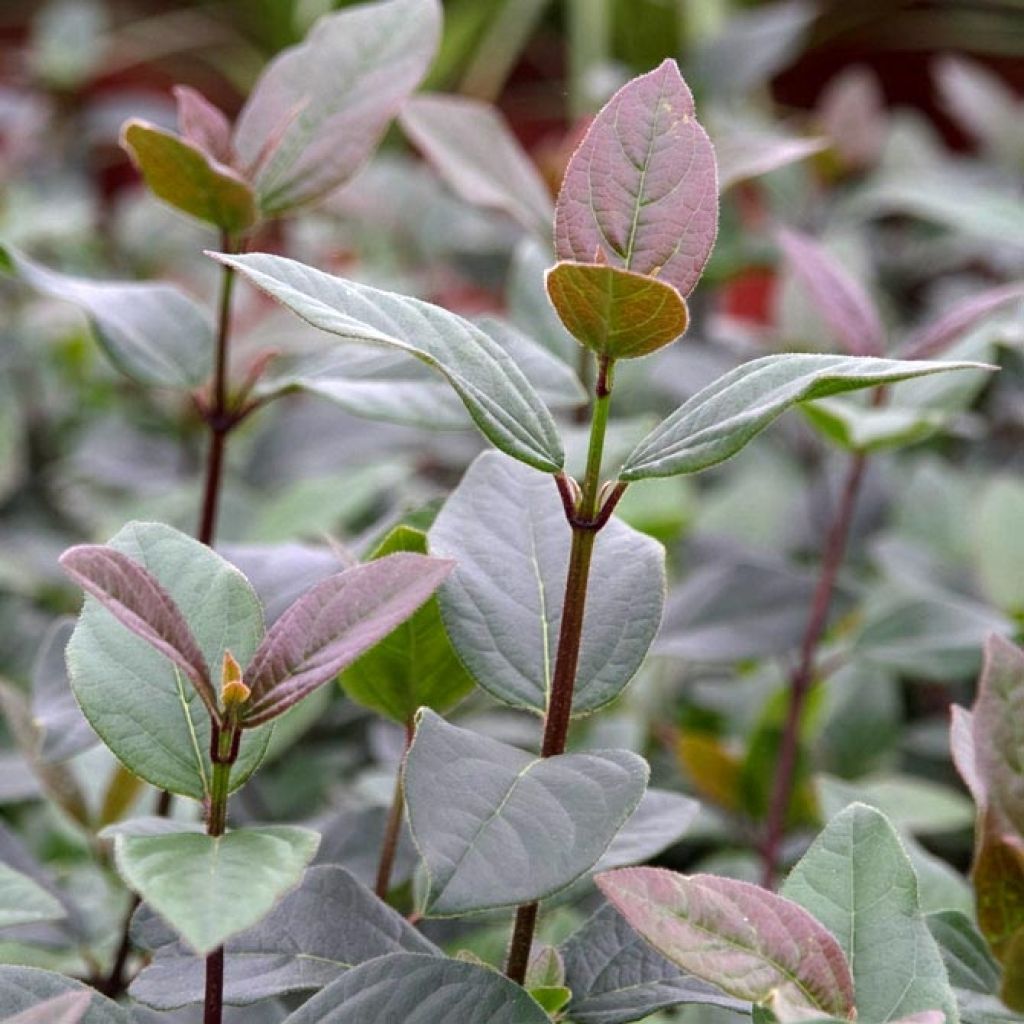

Viburnum tinus Purpureum
Viburnum tinus Purpureum
Viburnum tinus Purpureum
Laurustinus
This item cannot be shipped to the selected country
Delivery charge from €5.90
More information
Schedule delivery date,
and select date in basket
This plant carries a 24 months recovery warranty
More information
We guarantee the quality of our plants for a full growing cycle, and will replace at our expense any plant that fails to recover under normal climatic and planting conditions.
From €5.90 for pickup delivery and €6.90 for home delivery
Express home delivery from €8.90.

Does this plant fit my garden?
Set up your Plantfit profile →
Description
The Viburnum tinus 'Purpureum' is a tin laurel cultivar that stands out from the typical species by its beautifully coloured, purple-bronze spring leaves and its slightly smaller size. Its winter to spring small pink-white clusters of blooms, sometimes heralded in the autumn by decorative pink floral buds, add to its charm. Its very dense and abundant evergreen leaves are attractive all year round. It is a hassle-free garden plant, perfect for creating a privacy or windbreak hedge with no pruning requirements. Lastly, the tin laurel will adapt to any exposure, even shade, and to any soil, even very chalky and dry in summer.
The tinus Purpureum laurel belongs to the family of Caprifoliaceae, or Adoxaceae according to classifications. The Viburnum tinus species is native to the Mediterranean basin, is found in undergrowth, forest margins, and scrubland. It is a relatively cold-resistant evergreen bush (down to -15°C (5 °F) for short periods for an adult plant), which adapts to a wide range of soil types as long as they are not too wet or waterlogged in winter. Its fruits are consumed by birds that 'sow' the plant seeds under the trees they perch in: it is typically an undergrowth bush that copes perfectly with competition from other tree roots.
The moderately fast-growing Viburnum tinus Purpureum has a fairly upright, bushy and ramified habit from the base. It will reach about 1.75 m (5 ft 8 in) to 2 m (6 ft 7 in) in height with a 90 cm (35.4 in) girth. Its branches carry single, elliptical, pointed leaves at their end with undulate and villous borders, 8 to 10 cm (3.1 to 3.9 in) long by 3.5 to 4.5 cm (1.4 to 1.8 in) wide. They are of a leathery texture and slightly shiny. In the spring, the young leaves are deep purple, then turn bronze before becoming dark green at maturity. Flowering often starts in autumn, depending on the regions. The end of the year-old or over branches form cyme inflorescences that resemble small, round, and slightly domed clusters of 7 to 10 cm (2.8 to 3.9 in) in diameter. They are densely filled with pink floral buds which remain decorative all winter. These buds bloom from February to April as small flowers with 5 pink-white petals. This fragrant flowering is highly attractive to bees. After pollination, the flowers give way to ovoid 5 to 6 mm (0.2 to 0.2 in)-long berries, a metallic blue-black, containing a single seed. Tin laurel seeds must discard their pulp to be able to germinate: this step is naturally carried out by the digestive system of birds.
Really easy to grow, covered with leaves all year round, the tin laurel Purpureum is only averse to very harsh winters, especially when young. As it tolerates sea spray, it can confidently be grown in coastal areas. Like the Elaeagnus ebbingei, photinias, strawberry trees, myrtles and the Rhamnus alaternus Argenteovariegata, it is perfect for giving a permanent structure to a garden, especially in hot and dry regions where it thrives. Highly tolerant of shade and competition from other tree root systems, it is an excellent undergrowth filler. In a free hedge, it can also be combined with smoke bushes and deciduous spindle-trees with superb autumn colours. This tin laurel can also be grown in large pots. As it tolerates repeated pruning, it can be used in topiary art and be sculpted into original shapes.
Report an error about the product description
Plant habit
Flowering
Foliage
Botanical data
Viburnum
tinus
Purpureum
Caprifoliaceae
Laurustinus
Mediterranean
Other Laurustinus (Viburnum tinus)
Planting and care
The Viburnum tinus Purpureum is a very tolerant bush with regard to soil and exposure. Nonetheless, to ensure a good start, care should be taken to plant it in deeply well-worked soil to allow its roots to descend more quickly. In hot and dry climates, it is best to plant in early autumn, while spring planting is preferable in frost-prone regions. An adult bush will resist short frosts down to -12/-15°C in well-drained soil and in a sheltered position, shooting again from the stump if its vegetation has suffered damage. Water abundantly but in well-spaced out occasionsduring the first two or three summers to help the bush settle in well. Subsequently, it will totally do without water in summer, even in hot and dry regions. It is safer to shield young plants from any significant frosts with a cover during the first winters. The tin laurel is highly tolerant of limestone and clay soil as well as dry climates. It can also tolerate slightly acidic, bothcompact and wet soil in winter in the absence of frosts. It has no notable enemies in our gardens. This bush is very well adapted to drought and summer heat. It tolerates pruning very well, which allows it to be trained as a hedge or topiary. Tin laurels self-seeds very easily in the garden (especially under perching trees), through birds: pull out the young plants as soon as you have detected them.
Planting period
Intended location
Care
-
, onOrder confirmed
Reply from on Promesse de fleurs
Evergreen shrubs
Haven't found what you were looking for?
Hardiness is the lowest winter temperature a plant can endure without suffering serious damage or even dying. However, hardiness is affected by location (a sheltered area, such as a patio), protection (winter cover) and soil type (hardiness is improved by well-drained soil).

Photo Sharing Terms & Conditions
In order to encourage gardeners to interact and share their experiences, Promesse de fleurs offers various media enabling content to be uploaded onto its Site - in particular via the ‘Photo sharing’ module.
The User agrees to refrain from:
- Posting any content that is illegal, prejudicial, insulting, racist, inciteful to hatred, revisionist, contrary to public decency, that infringes on privacy or on the privacy rights of third parties, in particular the publicity rights of persons and goods, intellectual property rights, or the right to privacy.
- Submitting content on behalf of a third party;
- Impersonate the identity of a third party and/or publish any personal information about a third party;
In general, the User undertakes to refrain from any unethical behaviour.
All Content (in particular text, comments, files, images, photos, videos, creative works, etc.), which may be subject to property or intellectual property rights, image or other private rights, shall remain the property of the User, subject to the limited rights granted by the terms of the licence granted by Promesse de fleurs as stated below. Users are at liberty to publish or not to publish such Content on the Site, notably via the ‘Photo Sharing’ facility, and accept that this Content shall be made public and freely accessible, notably on the Internet.
Users further acknowledge, undertake to have ,and guarantee that they hold all necessary rights and permissions to publish such material on the Site, in particular with regard to the legislation in force pertaining to any privacy, property, intellectual property, image, or contractual rights, or rights of any other nature. By publishing such Content on the Site, Users acknowledge accepting full liability as publishers of the Content within the meaning of the law, and grant Promesse de fleurs, free of charge, an inclusive, worldwide licence for the said Content for the entire duration of its publication, including all reproduction, representation, up/downloading, displaying, performing, transmission, and storage rights.
Users also grant permission for their name to be linked to the Content and accept that this link may not always be made available.
By engaging in posting material, Users consent to their Content becoming automatically accessible on the Internet, in particular on other sites and/or blogs and/or web pages of the Promesse de fleurs site, including in particular social pages and the Promesse de fleurs catalogue.
Users may secure the removal of entrusted content free of charge by issuing a simple request via our contact form.
The flowering period indicated on our website applies to countries and regions located in USDA zone 8 (France, the United Kingdom, Ireland, the Netherlands, etc.)
It will vary according to where you live:
- In zones 9 to 10 (Italy, Spain, Greece, etc.), flowering will occur about 2 to 4 weeks earlier.
- In zones 6 to 7 (Germany, Poland, Slovenia, and lower mountainous regions), flowering will be delayed by 2 to 3 weeks.
- In zone 5 (Central Europe, Scandinavia), blooming will be delayed by 3 to 5 weeks.
In temperate climates, pruning of spring-flowering shrubs (forsythia, spireas, etc.) should be done just after flowering.
Pruning of summer-flowering shrubs (Indian Lilac, Perovskia, etc.) can be done in winter or spring.
In cold regions as well as with frost-sensitive plants, avoid pruning too early when severe frosts may still occur.
The planting period indicated on our website applies to countries and regions located in USDA zone 8 (France, United Kingdom, Ireland, Netherlands).
It will vary according to where you live:
- In Mediterranean zones (Marseille, Madrid, Milan, etc.), autumn and winter are the best planting periods.
- In continental zones (Strasbourg, Munich, Vienna, etc.), delay planting by 2 to 3 weeks in spring and bring it forward by 2 to 4 weeks in autumn.
- In mountainous regions (the Alps, Pyrenees, Carpathians, etc.), it is best to plant in late spring (May-June) or late summer (August-September).
The harvesting period indicated on our website applies to countries and regions in USDA zone 8 (France, England, Ireland, the Netherlands).
In colder areas (Scandinavia, Poland, Austria...) fruit and vegetable harvests are likely to be delayed by 3-4 weeks.
In warmer areas (Italy, Spain, Greece, etc.), harvesting will probably take place earlier, depending on weather conditions.
The sowing periods indicated on our website apply to countries and regions within USDA Zone 8 (France, UK, Ireland, Netherlands).
In colder areas (Scandinavia, Poland, Austria...), delay any outdoor sowing by 3-4 weeks, or sow under glass.
In warmer climes (Italy, Spain, Greece, etc.), bring outdoor sowing forward by a few weeks.


































